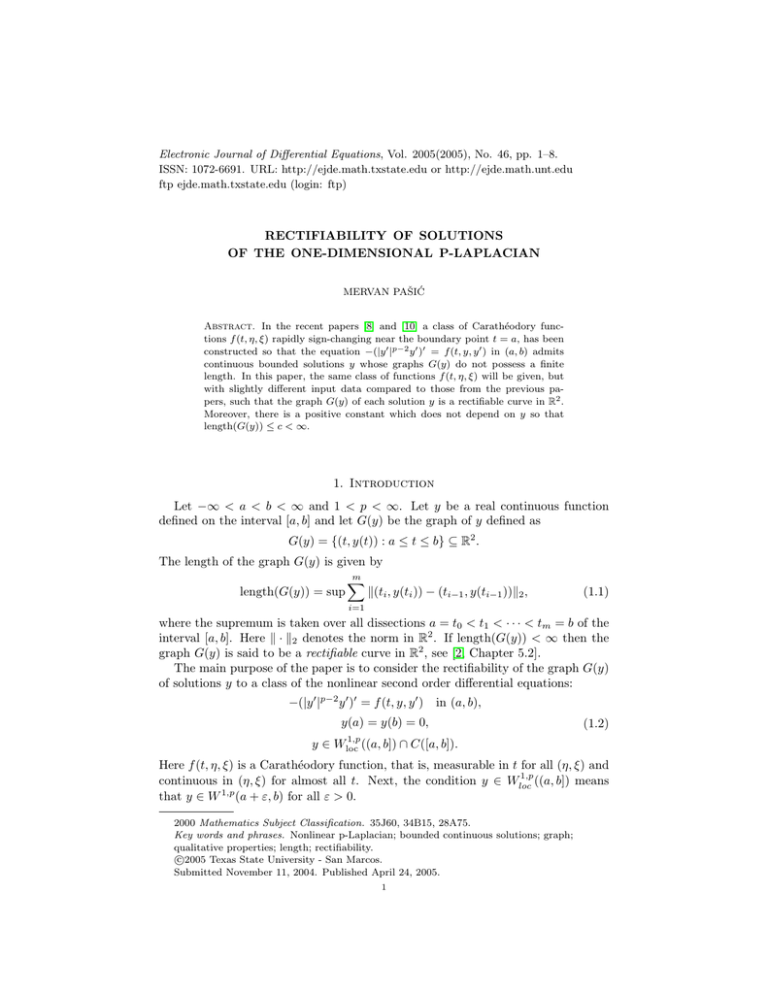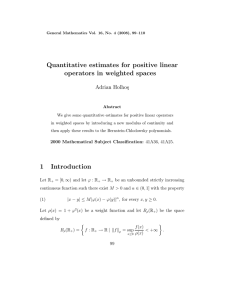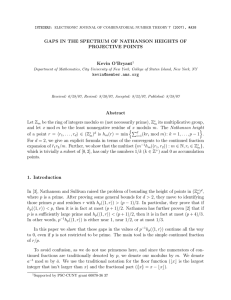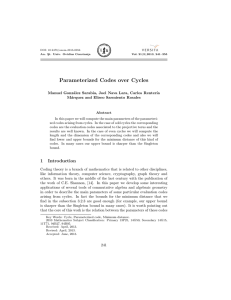Electronic Journal of Differential Equations, Vol. 2005(2005), No. 46, pp.... ISSN: 1072-6691. URL: or
advertisement

Electronic Journal of Differential Equations, Vol. 2005(2005), No. 46, pp. 1–8.
ISSN: 1072-6691. URL: http://ejde.math.txstate.edu or http://ejde.math.unt.edu
ftp ejde.math.txstate.edu (login: ftp)
RECTIFIABILITY OF SOLUTIONS
OF THE ONE-DIMENSIONAL P-LAPLACIAN
MERVAN PAŠIĆ
Abstract. In the recent papers [8] and [10] a class of Carathéodory functions f (t, η, ξ) rapidly sign-changing near the boundary point t = a, has been
constructed so that the equation −(|y 0 |p−2 y 0 )0 = f (t, y, y 0 ) in (a, b) admits
continuous bounded solutions y whose graphs G(y) do not possess a finite
length. In this paper, the same class of functions f (t, η, ξ) will be given, but
with slightly different input data compared to those from the previous papers, such that the graph G(y) of each solution y is a rectifiable curve in R2 .
Moreover, there is a positive constant which does not depend on y so that
length(G(y)) ≤ c < ∞.
1. Introduction
Let −∞ < a < b < ∞ and 1 < p < ∞. Let y be a real continuous function
defined on the interval [a, b] and let G(y) be the graph of y defined as
G(y) = {(t, y(t)) : a ≤ t ≤ b} ⊆ R2 .
The length of the graph G(y) is given by
m
X
length(G(y)) = sup
k(ti , y(ti )) − (ti−1 , y(ti−1 ))k2 ,
(1.1)
i=1
where the supremum is taken over all dissections a = t0 < t1 < · · · < tm = b of the
interval [a, b]. Here k · k2 denotes the norm in R2 . If length(G(y)) < ∞ then the
graph G(y) is said to be a rectifiable curve in R2 , see [2, Chapter 5.2].
The main purpose of the paper is to consider the rectifiability of the graph G(y)
of solutions y to a class of the nonlinear second order differential equations:
−(|y 0 |p−2 y 0 )0 = f (t, y, y 0 )
in (a, b),
y(a) = y(b) = 0,
y∈
1,p
Wloc
((a, b])
(1.2)
∩ C([a, b]).
Here f (t, η, ξ) is a Carathéodory function, that is, measurable in t for all (η, ξ) and
1,p
continuous in (η, ξ) for almost all t. Next, the condition y ∈ Wloc
((a, b]) means
1,p
that y ∈ W (a + ε, b) for all ε > 0.
2000 Mathematics Subject Classification. 35J60, 34B15, 28A75.
Key words and phrases. Nonlinear p-Laplacian; bounded continuous solutions; graph;
qualitative properties; length; rectifiability.
c
2005
Texas State University - San Marcos.
Submitted November 11, 2004. Published April 24, 2005.
1
2
M. PAŠIĆ
EJDE-2005/46
In the author’s paper [8], a class of Carathéodory functions f (t, η, ξ) rapidly signchanging and singular near the boundary point t = a has been constructed in such a
way that all solutions of the problem (1.2) admit very singular boundary behaviour.
It has been verified by means of the upper Minkowski-Bouligand dimension of the
graph G(y) of each solution y as well as by the order of growth for singular behaviour
of the Lp norm of the derivative of solutions. This can also be sharpened by the
use of notions of the upper Minkowski content and the s - dimensional density of
the graph G(y) of each solution y, as in the paper [10].
Taking a closer look at [8, Section 7], see also [10, Section 5], one can find that
there are two hypotheses involved to the nonlinear term f (t, η, ξ) which can reduce
the singular behaviour of the graph G(y) of each solution y of the problem (1.2).
In the first one, it is supposed that there is a continuous positive function ω̃(t) such
that:
f (t, η, ξ) < 0, t ∈ (a, b), η > ω̃(t) and ξ ∈ R,
(1.3)
f (t, η, ξ) > 0, t ∈ (a, b), η < −ω̃(t) and ξ ∈ R.
In the second one, it is supposed that there is a decreasing sequence ak of real
numbers from interval (a, b) such that ak & a and:
f (t, η, ξ) > 0,
t ∈ (a2k , a2k−1 ),
η ∈ (−ω̃0 , ω̃(t)) and ξ ∈ R,
f (t, η, ξ) < 0,
t ∈ (a2k+1 , a2k ),
η ∈ (−ω̃(t), ω̃0 ) and ξ ∈ R,
(1.4)
where ω̃0 is an arbitrarily given real number such that ω̃(t) ≤ ω̃0 for all t ∈ (a, b).
Because of (1.4), we say that the nonlinear term f (t, η, ξ) is rapidly sign-changing
near t = a.
In [8, Corollary 7.2], see also [10, Corollary 5.9], including the hypotheses (1.3)
and (1.4), a class of the functions ω̃(t) and a class of the sequences ak were given
in such a way that a type of the singular boundary behaviour of solutions of the
problem (1.2) is valid. In particular, one can conclude that the graph G(y) of each
solution y of (1.2) is not a rectifiable curve in R2 , that is to say, the graph G(y)
does not possess a finite length. This can be summarized this way.
Theorem 1.1. Let a Carathéodory function f (t, η, ξ) satisfy the hypotheses (1.3)
and (1.4) where the function ω̃(t) and the sequence ak are given by:
ω̃(t) = c(t − a)q
in [a, b], where c > 0 and q ∈ (0, 1),
(1.5)
1
ak = a + (b − a)( )1/β , ∀k ∈ N, where β > q.
k
Then problem (1.2) admits the solutions y ∈ C 2 (a, b) such that the graph G(y) is
not a rectifiable curve in R2 , that is to say, G(y) does not possess a finite length.
In this paper, under the hypotheses (1.3) and (1.4), one gives a possibility to
avoid the nonrectifiability of G(y) stated in Theorem 1.1. It will be done by choosing
a class of sequences ak from the interval (a, b) which decays exponentially to a, that
is to say, ak − a ≈ ce−kT as k ≈ ∞, for any c > 0 and T > 0. Such a class of
sequences ak is quite different from the previous one given in (1.5). It concerns the
following main result.
Theorem 1.2. Let a Carathéodory function f (t, η, ξ) satisfy the hypotheses (1.3)
and (1.4), where the function ω̃(t) is determined as in (1.5) and the sequence ak is
given by
ak = a + (b − a)e−(k−1)T , ∀k ∈ N, where T > 0.
(1.6)
EJDE-2005/46
RECTIFIABILITY OF SOLUTIONS
3
Then the graph G(y) of each solution y ∈ C 2 (a, b) of problem (1.2) is a rectifiable
curve in R2 . Moreover, there is a positive constant c which does not depend on y
so that:
length(G(y)) ≤ c < ∞.
(1.7)
Thus, under such a class of Carathéodory functions f (t, η, ξ), the rectifiability of
the graph G(y) of solutions of the problem (1.2) depends only on the appropriate
choice of the sequence ak appearing in (1.4).
The main statement (1.7) will be proved in Section 3, by the use of the upper
Minkowski content M 1 (G(y)) of the graph G(y) defined in Section 2. The first step
is to give a condition such that length(G(y)) ≤ M 1 (G(y)). The second step is to
derive an upper bound for M 1 (G(y)) which depends only on the behaviour of the
function ω̃(t) and of the sequence ak both appearing inside the main hypotheses
(1.3) and (1.4). Finally, at the end of Section 3, an example of such a class of
Carathéodory functions f (t, η, ξ) that satisfies the hypotheses (1.3) and (1.4) will
be given.
Further Remarks. A. The rectifiability of the graph G(y) considered in this paper
contributes to the completion of some results presented in the papers [8, Section 7]
and [10, Section 5].
B. Including the hypotheses (1.3) and (1.4), the existence of at least one solution
of the problem (1.2) was considered in [8, Appendix].
C. The main result of the paper can be applied to the study of rectifiable oscillations
of the second order differential equations. Such oscillations appears in the famous
linear Euler’s equation as well as in the p - Laplace equation, see [9].
D. Although the nonlinear term f (t, η, ξ) could have very singular behaviour near
t = a, the rectifiability of G(y) can be understood as a regular property of solutions
of the problem (1.2). As for some known results on the regularity of solutions for p
- Laplace equations, see for instance [3], [12], [13], and [14], and references therein.
2. How to measure the length of G(y)?
Let y be a real continuous function defined on the interval [a, b] and let the length
of the graph G(y), denoted by length(G(y)), be defined as in (1.1).
Since we are going to work with the solutions y of a nonlinear differential equation, from computational point of view, the formula (1.1) does not seem to be
convenient. For the purpose of proving the rectifiability of the graph G(y) and in
order to prove the main statement (1.7), we will calculate the length of the graph
G(y) by means of the upper Minkowski content M 1 (G(y)) as follows.
Let Gε (y) denote the ε− neighborhood of the graph G(y) and let |Gε (y)| denote
the Lebesgue measure of Gε (y). The upper Minkowski content of G(y), denoted by
M 1 (G(y)), is defined by
M 1 (G(y)) = lim sup(2ε)−1 |Gε (y)|.
ε→0
Referring to [2, Chapter 5.2], [6, Chapter 5.5] and [15, Chapter 9], it holds that
length(G(y)) = M 1 (G(y)),
(2.1)
provided the graph G(y) is a rectifiable curve in R2 . However, this result cannot be immediately used here because the condition of rectifiability of the graph
4
M. PAŠIĆ
EJDE-2005/46
G(y) is not yet presumed but it must be proved. Hence, we will use the following
complementary claim.
Lemma 2.1. Let y be a real continuous function defined on the interval [a, b] and let
y|[a+ε,b] denote the function restriction of y on the interval [a+ε, b]. We assume that
the graph G(y|[a+ε,b] ) is a rectifiable curve in R2 for all ε > 0. If M 1 (G(y)) < ∞
then the graph G(y) is also a rectifiable curve in R2 . Moreover, there holds true
lim length(G(y|[a+ε,b] )) = length(G(y)) ≤ M 1 (G(y)).
ε→0
Proof. By means of the rectifiability of the graphs G(y|[a+ε,b] ), ε > 0, and by the
use of (2.1) we observe that
length(G(y|[a+ε,b] )) = M 1 (G(y|[a+ε,b] )) ≤ M 1 (G(y)) < ∞,
∀ε > 0.
Since the sequence length(G(y|[a+ε,b] )) is increasing, while ε is decreasing, it implies
the existence of its limit which satisfies
lim length(G(y|[a+ε,b] )) ≤ M 1 (G(y)) < ∞.
ε→0
(2.2)
Next, it easy to check that:
length(G(y)) ≤ lim length(G(y|[a+ε,b] )).
ε→0
(2.3)
Indeed, for any given dissection a = t0 < t1 < · · · < tm = b of the interval [a, b]
we can set a dissection a + ε < t1 < · · · < tm = b of the interval [a + ε, b], for all
ε ∈ (0, t1 − a). Since y is a continuous function on [a, b], by means of the definition
(1.1) we derive
m
X
k(ti , y(ti )) − (ti−1 , y(ti−1 ))k2
i=1
= lim [k(t1 , y(t1 )) − (a + ε, y(a + ε))k2 +
ε→0
m
X
k(ti , y(ti )) − (ti−1 , y(ti−1 ))k2 ]
i=2
≤ lim length(G(y|[a+ε,b] )).
ε→0
Taking the supremum over all dissections of the interval [a, b] from the previous
inequality follows (2.3).
We complete the proof of this lemma by noting that length(G(y|[a+ε,b] )) ≤
length(G(y)) for any ε > 0, and combining this inequality with (2.2) and (2.3). With the help of Lemma 2.1 applied to solutions of the problem (1.2) we obtain
the following consequence.
Corollary 2.2. For all solutions y of the problem (1.2) such that M 1 (G(y)) < ∞
we have
length(G(y)) = M 1 (G(y)).
(2.4)
1,p
Proof. Let y be a solution of (1.2). Let us mention that y ∈ Wloc
((a, b]), that is to
1,p
say, y ∈ W (a + ε, b) for all ε > 0. It implies that y is an absolutely continuous
function (of bounded variation) on [a + ε, b]. Therefore, the graph G(y|[a+ε,b] ) is a
rectifiable curve in R2 for all ε > 0. Since M 1 (G(y)) < ∞, we may apply Lemma
2.1 to obtain length(G(y)) ≤ M 1 (G(y)) < ∞. Now, it is possible to use (2.1) and
thus, (2.4) is shown.
EJDE-2005/46
RECTIFIABILITY OF SOLUTIONS
5
Thus, according to Corollary 2.2, in order to prove the rectifiability of G(y) it is
enough to show that M 1 (G(y)) < ∞. For this we need the following general result.
Lemma 2.3. Let ω̃(t) be a continuously increasing and concave function such that
ω̃(a) = 0. Next, let a1 = b and let ak be a decreasing sequence of real numbers from
interval (a, b) satisfying:
ak & a and there is an ε1 > 0 such that for all ε ∈ (0, ε1 )
there is an m(ε) ∈ N such that aj−1 − aj > 4ε, for each j ≤ m(ε),
(2.5)
and m(ε) → ∞ as ε → 0.
Let a Carathéodory function f (t, η, ξ) satisfy hypotheses (1.3) and (1.4). Then the
graph G(y) of each solution y ∈ C 2 (a, b) of problem (1.2) satisfies
M 1 (G(y)) ≤ (π + 6)(b − a) + (π + 6)
∞
X
ω̃(aj )
j=1
(2.6)
1
+ lim sup[ (am(ε) − a)ω̃(am(ε) ) + (π + 4)ε m(ε)].
ε
ε→0
Proof. With the help of hypothesis (1.3) and [8, Lemma 3.1], we have that each
solution y ∈ C 2 (a, b) of problem (1.2) satisfies
−ω̃(t) ≤ y(t) ≤ ω̃(t),
for all t ∈ [a, b].
(2.7)
Next, taking into account hypothesis (1.4) and [8, Remark A in Appendix], we have
also that
y is concave in (a2k , a2k−1 )
and y is convex in (a2k+1 , a2k ),
(2.8)
for each k ≥ 1. Now, according to assertions (2.5), (2.7) and (2.8) it is clear
the all assumptions of [10, Definition 5.1] and [10, Lemma 5.3] are fulfiled, where
˜ = ω̃(t) and θ̃(t) = −ω̃(t). So, by means of [10, Lemma 5.3], we obtain
ω̃(t)
|Gε (y|[a,a1 ] )| ≤ 2(am(ε) − a + 2ε)(ω̃(am(ε) ) + ε)
m(ε)
+ 2(π + 6)ε
X
[ω̃(aj−1 ) + (aj−1 − aj )] + 2(π + 4)ε2 m(ε),
j=2
where a1 = b. Since m(ε) → ∞, am(ε) → a, and ω̃(0) = 0, the right hand side in
the previous inequality can be simplified and so, the statement (2.6) is proved. As a consequence of the preceding lemma we have the following statement.
Corollary 2.4. Let the hypotheses of Lemma 2.3 be still fulfilled. Let ω̃(t) and ak
be such that there are three positive constants c1 , c2 and c3 satisfying
∞
X
ω̃(aj ) ≤ c1 ,
(am(ε) − a)ω̃(am(ε) ) ≤ c2 ε,
and
ε m(ε) ≤ c3 ,
(2.9)
j=1
for sufficiently small ε. Then there is a positive constant c such that each solution
y ∈ C 2 (a, b) of the problem (1.2) satisfies M 1 (G(y)) ≤ c < ∞.
Thus, according to Corollary 2.2, in order to prove (1.7), we need to ensure that
a class of the functions ω̃(t) given in (1.5) and a class of the sequences ak given in
(1.6) satisfy all the assumptions of Corollary 2.4.
6
M. PAŠIĆ
EJDE-2005/46
3. The proofs of the main results and an example
Sketch of the proof of Theorem 1.1. Including some additional assumptions on the
Caratheodory function f (t, η, ξ) which are completely balanced with the main hypotheses (1.3) and (1.4), one can show (see in [8, Corollary 7.2] and [10, Corollary
5.9]) that the graph G(y) of each solution y ∈ C 2 (a, b) of the problem (1.2) satisfies:
dimM G(y) = s and 0 < M s (G(y) < ∞,
(3.1)
where s is a prescribed real number, s ∈ (1, 2). Here dimM G(y) denotes the upper
Minkowski-Bouligand dimension and M s (G(y) denotes the s-dimensional upper
Minkowski content of G(y) defined by
log |Gε (y)| and M s (G(y)) = lim sup(2ε)s−2 |Gε (y)|.
dimM G(y) = lim sup 2 −
log ε
ε→0
ε→0
The existence of at least one solution y of the problem (1.2) satisfying the preceding
properties was given in [8, Appendix]. Let us mention a very well known relation
between dimM G(y) and M s (G(y):
dimM G(y) = inf{s ≥ 0 : M s (G(y)) = 0} = sup{s ≥ 0 : M s (G(y)) = ∞},
(3.2)
1
Since s > 1 and combining (3.1) with (3.2) we obtain that M (G(y)) = ∞. With
the help of (2.1), it follows that the graph G(y) does not possess a finite length. Next, we give the proof of the main result of the paper.
Proof of Theorem 1.2. Let us mention that the function ω̃(t) and the sequence ak
are given by
ω̃(t) = c(t − a)q
in [a, b], where c > 0 and q ∈ (0, 1),
−(k−1)T
ak = a + (b − a)e
,
∀k ∈ N, where T > 0.
(3.3)
According to Corollary 2.4, it is sufficient to show that such ω̃(t) and ak satisfy
the all conditions of Lemma 2.3 as well as condition (2.9).
It is clear that the function ω̃(t) is continuous and concave in (a, b), and that
ω̃(0) = 0. Also, the sequence ak is decreasing, a1 = b and ak & a.
Let m(ε) be a sequence of integers determined by the following inequality:
(eT − 1)(b − a)
1
(e2T − eT )(b − a)
1
ln
≤ m(ε) ≤ ln
, ε > 0.
(3.4)
T
4ε
T
4ε
With the help of (3.3) and (3.4) it is easy to check the following calculations. Firstly,
we derive that
1
(e2T − eT )(b − a)
1
(eT − 1)(b − a)
1
ln
− ln
= ln eT = 1.
(3.5)
T
4ε
T
4ε
T
Also, for each j ≤ m(ε), we obtain
aj−1 − aj = (b − a)(e2T − eT )e−jT ≥ (b − a)(e2T − eT )e−m(ε)T
1
≥ (b − a)(e2T − eT )e− T T ln
(e2T −eT )(b−a)
4ε
(3.6)
= 4ε.
Next, there is a positive constant c1 such that for all ε > 0 we obtain:
∞
X
j=1
ω̃(aj ) = c
∞
X
j=1
(aj − a)q = c(b − a)q eqT
∞
X
j=1
e−jqT ≤ c1 .
(3.7)
EJDE-2005/46
RECTIFIABILITY OF SOLUTIONS
7
Furthermore, there is a positive constant c2 such that for all ε > 0 we derive
(am(ε) − a)ω̃(am(ε) ) = c[(b − a)eT ]q+1 e−(q+1)T m(ε)
≤ c[(b − a)eT ]q+1 e−T m(ε)
1
≤ c[(b − a)eT ]q+1 e−T T
ln
(3.8)
(eT −1)(b−a)
4ε
= c2 ε.
Since limε→0 [ε ln(1/ε)] = 0, there is a positive constant c3 such that for all ε > 0
we have:
ε
(e2T − eT )(b − a)
ε m(ε) ≤ ln
≤ c3 .
(3.9)
T
4ε
We now conclude with the help of (3.5) that it is possible to choose a m(ε) ∈ N
in the statement (3.4). Also, according to (3.6) we obtain that the sequence ak
satisfies the condition (2.5), where ε1 can be taken arbitrarily.
Next, by means of (3.7), (3.8) and (3.9) we obtain that the function ω̃(t) and
the sequence ak satisfy all the conditions from (2.9). Therefore, we may apply
Corollary 2.4 which immediately gives the desired statement (1.7).
Example 3.1. Let gk (t) be an arbitrarily given sequence of measurable functions
such that gk (t) > 0 in (a, b), for each k = 0, 1, 2, . . . . Let f (t, η, ξ) be a nonlinear
function defined by:
f (t, η, ξ) = − g0 (t)(η − ω̃(t))+ + g1 (t)(η + ω̃(t))−
∞
X
g2k (t)(η − ω̃(t))− sin(
π
(t − a2k ))K[a2k ,a2k−1 ] (t)
a2k−1 − a2k
k=1
π
(t − a2k+1 ))K[a2k+1 ,a2k ] (t) ,
− g2k+1 (t)(η + ω̃(t))+ sin(
a2k − a2k+1
+
where t ∈ [a, b], η ∈ R and ξ ∈ R. Here KA (t) denotes, as usual, the characteristic
function of a set A and also, η − = max{0, −η} and η + = max{0, η}. It is easy to
check that such a function f (t, η, ξ) is of Carathéodory type and that it satisfies
the desired hypotheses (1.3) and (1.4).
References
[1] G. Bouligand; Dimension, Etendue, Densité, C. R. Acad. Sc. Paris, 180 (1925), 246-248.
[2] K. Falconer; Fractal Geometry. Mathematical Fondations and Applications, John WilleySons, 1999.
[3] L. Korkut, M. Pašić and D. Žubrinić; Some qualitative properties of solutions of quasilinear
elliptic equations and applications, J. Differential Equations, 170 (2001), 247-280.
[4] A. Le Méhauté; Fractal Geometries. Theory and Applications, Hermes, Paris, 1990.
[5] J. L. Lions; Quelques méthodes de résolution des problèmes aux limites non linéaires, Dunod,
Paris, 1969.
[6] P. Mattila; Geometry of Sets and Measures in Euclidean Spaces. Fractals and rectifiability,
Cambridge, 1995.
[7] D. O’Regan; Existence theory for nonlinear ordinary differential equations, Kluwer, 1997.
[8] M. Pašić; Minkowski - Bouligand dimension of solutions of the one-dimensional p-Laplacian,
J. Differential Equations, 190 (2003), 268-305.
[9] M. Pašić; Second order rectifiable oscillations, in preparation.
[10] M. Pašić and V. Županović; Some metric-singular properties of the graph of solutions of the
one-dimensional p-Laplacian, Electron. J. Diff. Eqns., 2004 (2004), No. 60, 1-25.
[11] H. O. Peitgen, H. Jűrgens, and D. Saupe; Chaos and Fractals. New Frontiers of Science,
Springer-Verlag, 1992.
8
M. PAŠIĆ
EJDE-2005/46
R
[12] J. M. Rakotoson; Equivalence between the growth of B(x,r) |∇u|p dy and T in the equation
P (u) = T , J. Differential Equations, 86 (1990), 102-122.
[13] J. M. Rakotoson and R. Temam; A co-area formula with applications to monotone rearrangement and to regularity, Arch. Rational Mech. Anal., 109 (1990), 213-238.
[14] J. M. Rakotoson and W. P. Ziemer; Local behavior of solutions of quasilinear elliptic equations
with general structure, Trans. Amer. Math. Soc., 319 (1990), 747-764.
[15] C. Tricot; Curves and Fractal Dimension, Springer-Verlag, 1995.
Mervan Pašić
Department of Mathematics, Faculty of Electrical Engineering and Computing, University of Zagreb, Unska 3, 10000 Zagreb, Croatia
E-mail address: mervan.pasic@fer.hr








